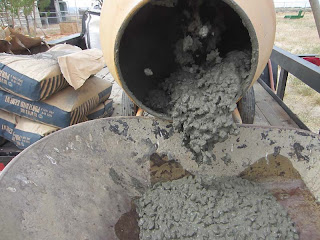Paul is our awesome awesome welder guy. This is what Paul did.

First, we laid out (very roughly) where doors and windows would go. 46" from the floor, then a 36" window.

Then we (Alan) cut all of the crap off of the outside (these were used as storage racks for building material)
Once the exact window placement was decided, the windows were more accurately laid out and squared. This was done by first measuring the rough opening, then putting a mark on the wall. The marks were then squared by the Pythagorean theorem (working with mathematicians means we do things the weird way), and a pop rivet was poked through the wall at each outside corner of the window.
This meant that we had an exact measurement on the outside by which to draw the cutting guidelines.

Then Paul came over. This picture is the only one I really have of him cutting the main bits, because any time we're working directly with the surface of the container in a way that might involve atomized paint (welding, cutting, grinding), you need to wear a respirator with a HEPA "P100 filters [which] provide a 99.97% efficiency level for removing particles sized at 0.3 microns or larger". There's some nasty stuff in there you really don't want to breathe. And I left mine at home.
The doors come off:

I apologize for the pictures being so terrible, by my little point and shoot camera was not happy trying to deal with all of the light from the plasma cutter and all of the
dark from the fact that it was 10pm.

We have windows! It makes it look so much smaller for some reason.
At the end of all of this I'm probably going to do some posts with the nicer pictures I've taken that don't really further the explanation of construction.

First, we laid out (very roughly) where doors and windows would go. 46" from the floor, then a 36" window.

Then we (Alan) cut all of the crap off of the outside (these were used as storage racks for building material)
Once the exact window placement was decided, the windows were more accurately laid out and squared. This was done by first measuring the rough opening, then putting a mark on the wall. The marks were then squared by the Pythagorean theorem (working with mathematicians means we do things the weird way), and a pop rivet was poked through the wall at each outside corner of the window.
This meant that we had an exact measurement on the outside by which to draw the cutting guidelines.

Then Paul came over. This picture is the only one I really have of him cutting the main bits, because any time we're working directly with the surface of the container in a way that might involve atomized paint (welding, cutting, grinding), you need to wear a respirator with a HEPA "P100 filters [which] provide a 99.97% efficiency level for removing particles sized at 0.3 microns or larger". There's some nasty stuff in there you really don't want to breathe. And I left mine at home.
The doors come off:

I apologize for the pictures being so terrible, by my little point and shoot camera was not happy trying to deal with all of the light from the plasma cutter and all of the
dark from the fact that it was 10pm.

We have windows! It makes it look so much smaller for some reason.
At the end of all of this I'm probably going to do some posts with the nicer pictures I've taken that don't really further the explanation of construction.


















